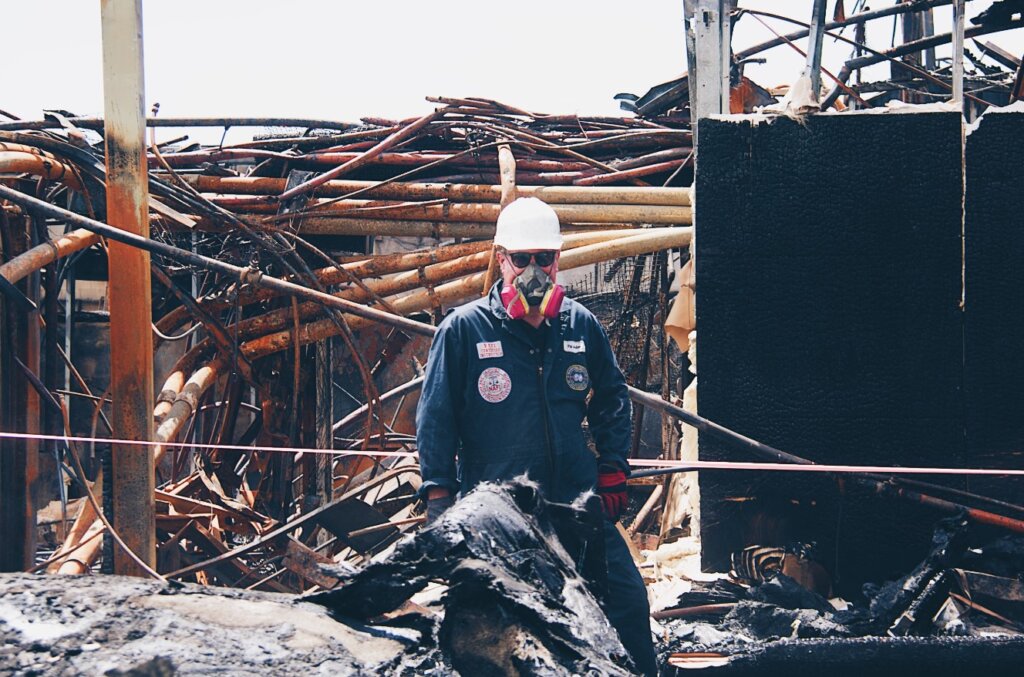As a fire investigative company, Andler & Associates has had the opportunity, over the years, to host, attend, and participate in many fire scene inspections.
Fire scenes are obviously the result of a fire at a home or business and in many cases involve potential litigation, which means attorneys are involved.
Attorneys become involved for several reasons in fire scenes. This to include, bad faith claims against their own insurance company, personal injury or death, product representation, subrogation, and criminal defense to name some.
Fire scenes can be dangerous and should always be approached cautiously with safety being first and foremost.
It has become routine, in many cases, for attorneys involved to attend the scene inspections with their fire expert so they have a better understanding of the facts and evidence in the case. Often, this involves going into burned structures, homes, or commercial buildings and this can be dangerous without the proper safety equipment.
NFPA 921 (National Fire Protection Association) Guide to Fire and Explosion Investigations is the industry leading journal on proper fire investigative procedures. This book has been referred to by many courts and jurisdictions as being the standard for fire investigations. One example is cited in McCoy v. Whirlpool Corp., District of Kansas 2003 U.S. Dist. LEXIS 6901, wherein it states, “The “gold standard” for fire investigations is codified in NFPA 921, and its testing methodologies are well known in the fire investigation community and familiar to the courts.”
NFPA 921 addresses fire scene safety in Chapter 13 of that journal. Specifically, it starts out by stating.
NFPA 921 13.1 Fire scenes, by their nature, are dangerous places. Fire investigators have an obligation to themselves and perhaps to others (such as other investigators, equipment operators, laborers, property owners, attorneys) who may be endangered at fire scenes during the investigation process. This chapter will provide the investigator with some basic recommendations concerning a variety of safety issues, including personal protective equipment (PPE). It should be noted, however, that the investigator should be aware of and follow the applicable requirements of safety-related laws (OSHA, federal, or state) or those policies and procedures established by their agency, company, or organization.
On many occasions, attorneys may find it necessary to attend a fire scene inspection with their expert. When doing this one should always follow protocol and remember if you are going to walk around in the fire scene, you must meet the safety requirements for that scene. Generally, fire scene inspections involve a protocol that has been written by one of the parties involved and agreed upon by all parties invited to the inspection. These protocols although they may all contain the basic safety rules, some may include specialized instructions, warnings, or other directives based upon the hazards presented by that particular scene.
NFPA 921-chapter 13 addresses safety issues for fire scenes and investigators and is filled with ten pages of directives. The intent of this article is to bring awareness to relevant safety issues while attending a fire scene inspection and not to address every concern cited within the aforementioned chapter.
With the current times we’re all faced with now involving the pandemic, we should be even more safety conscious and receptive to better practices for health and safety concerns. If it is acceptable to ask someone to leave a store or business because they are not wearing a mask or practicing social distancing, then certainly it should be acceptable to ask someone to leave or not enter a fire scene that is not practicing the safety requirements in the protocol for that fire scene.
It has been said on many scenes by attorneys, adjusters, and others, “I just want to take a quick look, I won’t touch anything.” “I’m just going to step inside the door and snap a quick picture with my phone.” “Show me what started the fire and where, and I’ll be out of here.”
These are just some of the many pleadings heard by me and other fire investigators over the years. Often, when someone wants to enter the fire scene that is not properly protected it is early in the inspection process and the origin and cause are still very much unknown. Fire investigations can be lengthy and painstaking processes. This is largely in part because of the many safety hazards that exist at practically every fire scene.
Some of the Many Hazards at Fire Scenes
- Air borne carcinogenic particulates, a respirator is a must for fire scenes and should be worn at ALL times while inside the fire scene.
- Hand injuries, gloves should be worn while in a fire scene. Often when in a fire scene one could easily lose their balance or trip and need to put the hand down to brace themselves.
- Sharp objects often lie underneath rubble on the floor covered by debris that can easily penetrate regular footwear and penetrate the skin. Protective boots with steel toe and shank in the base are a necessity for fire scenes.
- Biological hazards can exist in cases where there was injury or death and should be recognized and prepared for appropriately. This at very least is not something you want to get onto your personal clothing or shoes that will be carried back into your vehicle, office and ultimately your home to share with your family. The well-known Theory of Transfer and Exchange describes this phenomenon, and we should be cognizant of it on every fire scene.
- Slip, trip and fall hazards exist at practically every fire scene. Imagine everything within a structure being attacked by fire including all the items under your kitchen sink soaps, cleaners, oils, and many other slippery liquids. These will now all be throughout the structure ready for anyone in the fire scene to encounter them. This, combined with the many other items within the structure that have been displaced, broken, dislodged, or knocked down are all potential hazards and must be prepared for. In many instances a certain amount of excavation needs to be done prior to entering the scene and sometimes even walls need to be shored up prior to being able to safely perform the investigation.
- Low hanging construction materials are present in many fire scenes including metal and wood pieces that always necessitate a hard hat for everyone in the fire scene.
- Chemical hazards routinely exist at fire scenes as containers holding dangerous liquids and powders have now been jeopardized by the fire and the contents of that container are now with you inside the fire scene. This is where the respirator, gloves, protective boots can be useful. If necessary, biohazard suits can also be deployed when conditions dictate.
As stated, these are only some of the many hazards that can and do exist in fire scenes. Fire investigators often are called upon to host a scene inspection involving other interested parties including attorneys from both sides of the fence. It should be part of every scene protocol to include good safety procedures based upon that individual fire scene. These protocols MUST be adhered to by all present including attorneys. By being aware of the potential hazards that can and do exist and reviewing protocols prior to showing up for an inspection, this can allow the attorney to walk through the fire scene and work cooperatively with their expert in gaining a better understanding of the facts and circumstances surrounding this particular loss. A suggestion to those that want to visit and be and active participant in their fire case, SAFETY UP.
Do not wear open toe shoes or any other footwear that would not be suitable for walking through a fire scene on the day of your fire scene inspection, invest in some work boots with steel toe and shank in them.
Lastly, attorneys should consult with their experts and discuss what safety measures need to be included in the protocol and adhered to the day of the inspection. With clear and concise rules in place it should alleviate any misunderstandings and most importantly, keep everyone safe.










